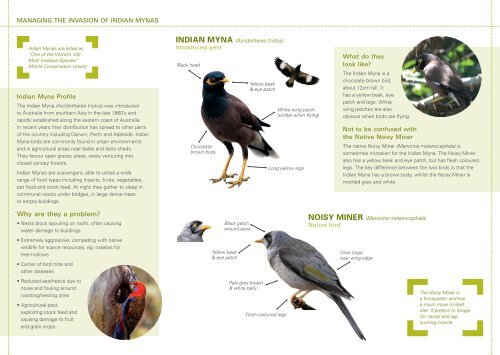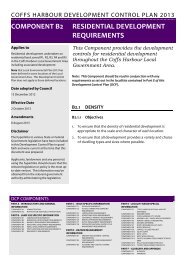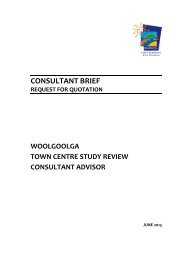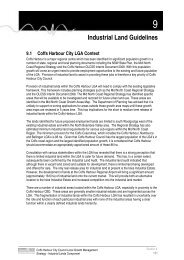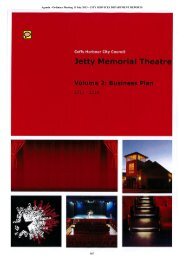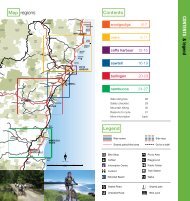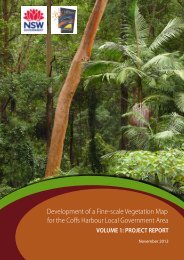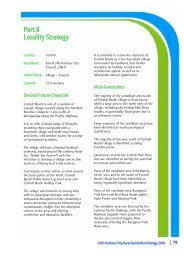Indian Myna Bird Pamphlet - Coffs Harbour City Council
Indian Myna Bird Pamphlet - Coffs Harbour City Council
Indian Myna Bird Pamphlet - Coffs Harbour City Council
You also want an ePaper? Increase the reach of your titles
YUMPU automatically turns print PDFs into web optimized ePapers that Google loves.
Managing the invasion of <strong>Indian</strong> <strong>Myna</strong>s<br />
<strong>Indian</strong> <strong>Myna</strong>s are listed as<br />
“One of the World’s 100<br />
Most Invasive Species”<br />
(World Conservation Union)<br />
<strong>Indian</strong> <strong>Myna</strong> Profile<br />
The <strong>Indian</strong> <strong>Myna</strong> (Acridotheres tristus) was introduced<br />
to Australia from southern Asia in the late 1860’s and<br />
rapidly established along the eastern coast of Australia.<br />
In recent years their distribution has spread to other parts<br />
of the country including Darwin, Perth and Adelaide. <strong>Indian</strong><br />
<strong>Myna</strong> birds are commonly found in urban environments<br />
and in agricultural areas near bales and dairy sheds.<br />
They favour open grassy areas, rarely venturing into<br />
closed canopy forests.<br />
<strong>Indian</strong> <strong>Myna</strong>s are scavengers, able to utilise a wide<br />
range of food types including insects, fruits, vegetables,<br />
pet food and stock feed. At night they gather to sleep in<br />
communal roosts under bridges, in large dense trees<br />
or empty buildings.<br />
<strong>Indian</strong> <strong>Myna</strong> (Acridotheres tristus)<br />
Introduced pest<br />
Black head<br />
Chocolate<br />
brown body<br />
Yellow beak<br />
& eye patch<br />
White wing patch<br />
(visible when flying)<br />
Long yellow legs<br />
What do they<br />
look like<br />
The <strong>Indian</strong> <strong>Myna</strong> is a<br />
chocolate brown bird,<br />
about 12cm tall. It<br />
has a yellow beak, eye<br />
patch and legs. White<br />
wing patches are also<br />
obvious when birds are flying.<br />
Not to be confused with<br />
the Native Noisy Miner<br />
The native Noisy Miner (Manorina melanocephala) is<br />
sometimes mistaken for the <strong>Indian</strong> <strong>Myna</strong>. The Noisy Miner<br />
also has a yellow beak and eye patch, but has flesh coloured<br />
legs. The key difference between the two birds is that the<br />
<strong>Indian</strong> <strong>Myna</strong> has a brown body, whilst the Noisy Miner is<br />
mottled grey and white.<br />
Why are they a problem<br />
• Nests block spouting on roofs, often causing<br />
water damage to buildings.<br />
• Extremely aggressive, competing with native<br />
wildlife for scarce resources, eg. rosellas for<br />
tree hollows<br />
• Carrier of bird mite and<br />
other diseases<br />
• Reduced aesthetics due to<br />
noise and fouling around<br />
roosting/nesting sites<br />
• Agricultural pest,<br />
exploiting stock feed and<br />
causing damage to fruit<br />
and grain crops.<br />
Black patch<br />
around eyes<br />
Yellow beak<br />
& eye patch<br />
Pale grey breast<br />
& white belly<br />
Flesh coloured legs<br />
noisy miner (Manorina melanocephala)<br />
Native bird<br />
Olive tinge<br />
near wing edge<br />
The Noisy Miner is<br />
a honeyeater and has<br />
a much more limited<br />
diet. It prefers to forage<br />
for nectar and sap<br />
sucking insects.


